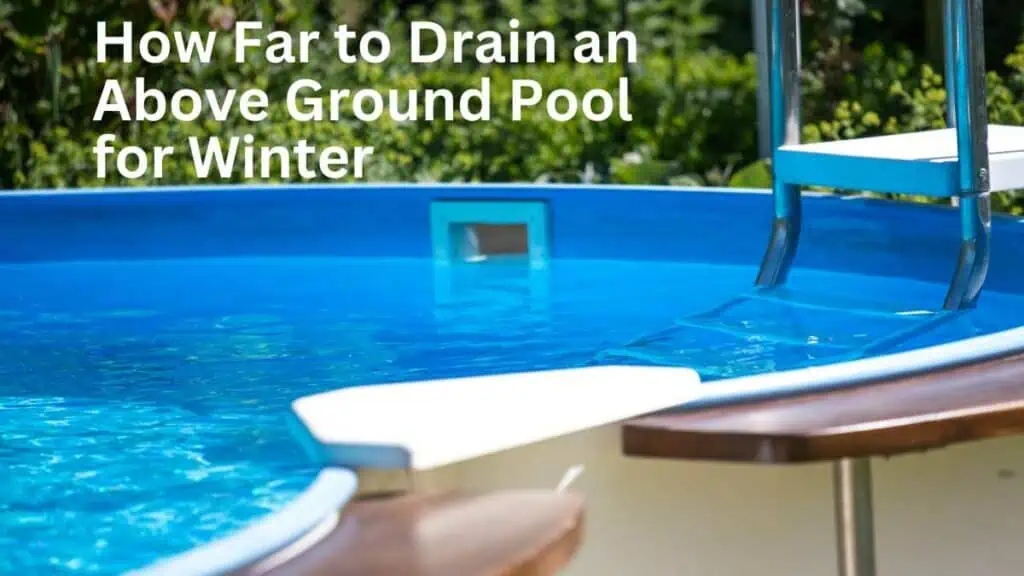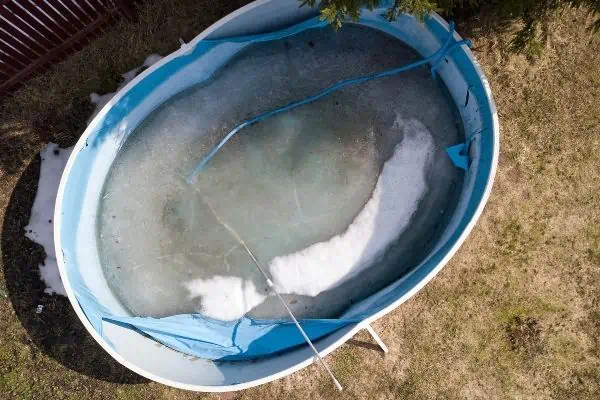As the winter season approaches (sadly), it’s crucial to prepare your above-ground pool for freezing temperatures, assuming you live in an area with such a cold climate.
One key aspect of winterizing your pool is determining how far to drain the water.
Draining your pool the correct amount can help prevent damage to the liner, walls, and skimmer and reduce the risk of frozen pipes. With the right guidance and preparation, you can ensure your pool remains in optimal condition throughout the chilly season.
In this article, we will explain how far below the skimmer to drain the pool for winter for various types of above-ground pools.

Pool Winterization Video Course
Using Swim University’s step-by-step video course, you can close and winterize your pool yourself, saving over $300 a year. The course covers closing both inground and aboveground pools.

Listen to our Pool Winterization Podcast to find out more:
Why Drain an Above-Ground Pool for Winter?
Draining an above-ground pool for winter is important for many reasons.
First and foremost, it helps protect your pool from potential damage caused by freezing temperatures. When water freezes, it expands, stressing your pool’s structure and liner.
Lowering the water level reduces the risk of the pool liner stretching or tearing due to ice expansion. Additionally, properly draining your pool prevents damage to the skimmer and other essential components.
A lower water level also minimizes the chances of water infiltrating and interfering with the pool cover, which could cause it to sag or tear.
How Far to Drain Your Pool
When preparing your above-ground pool for winter, it is important to drain the water appropriately. Draining your pool entirely is not advisable, as it can leave dirt and debris in the bottom of the pool after winterizing and the vinyl liner could become damaged if it dries out.
There are a couple of methods you can use to drain your pool.
- One option is to use a submersible pump, which involves connecting a hose to the pump and directing the water away from the pool area.
- Another option is to use a siphon, which uses gravity to create suction and pull water out of the pool.
There are a few key factors to consider when determining how far to drain your above-ground pool for winter.
Type of Cover
It is important to consider the type of pool cover you will be using.
If you use a floating cover, drain the water level to about 6 inches below the skimmer or the bottom of the returns.
If using a standard non-porous winter cover, remove enough water to reach a level approximately 6 inches below the skimmer.
If you opt for a mesh cover, you can drain the water up to 12 inches below the skimmer to allow for winter rain to fill the pool through the cover. With a mesh cover, you may need to pump out some water if the level increases up to the skimmers and returns.
Pool Size and Material
One of the primary factors impacting the draining distance of your above-ground pool is the type of pool you have.
There are two main types of above-ground pools: steel and fiberglass. Steel pools usually require more water removal because they are less strong than fiberglass pools.
It is generally suggested that the pool be drained between 4 and 6 inches below the bottom of the skimmer mouth for above-ground pools with a vinyl liner. This ensures enough space for water to expand and contract during winter.

Preparing Your Pool for Winter
Cleaning and Chemical Treatment
Before winterizing your above-ground pool, it’s essential to clean it thoroughly.
Begin by removing any leaves or debris accumulated on the surface and at the bottom of the pool. Scrub the walls and floor with a pool brush to ensure the pool is algae-free.
Next, check and balance your pool water chemistry. To protect your pool during winter, ensure the pH level is between 7.2 and 7.6, alkalinity is between 80 and 120 ppm, and calcium hardness is between 180 and 220 ppm.
Once your pool water is balanced, add a winterizing chemical kit or winter pool pill to prevent algae growth and equipment corrosion.
Pool Cover Installation
Installing a pool cover is crucial in preparing your pool for winter. A high-quality winter cover will protect your pool from debris, leaves, and snow during the cold months.
Before installation, make sure the cover is clean and free of damage. Then, securely fasten the cover over the pool, ensuring it is tight and properly anchored. This will prevent it from sagging under the weight of snow and ice.
Read my article Best Above Ground Pool Winter Covers if you don’t have one.
Place an air pillow underneath the cover in the center of the pool. This helps to distribute the weight of snow and ice evenly across the cover, reducing the risk of damage. It also allows ice on the pool’s surface to “squeeze” the pillow rather than squeeze the sides of the pool, which might damage it.
Other related articles you might find useful:
Can You Leave Steps in Above Ground Pool for Winter?
How to Winterize an Above Ground Pool
Frequently Asked Questions
Should I drain my above-ground pool for winter?
It depends on the type of pool you have and the climate you live in, but generally, it is not recommended to drain your above-ground pool for winter. Instead, you should winterize your pool by balancing the water, adding winterizing chemicals, protecting your pump and filter, and covering it.
Do I need to store small above-ground pools away for winter?
If your above-ground pool is plastic and smaller than 20 by 40 feet, it’s best to disassemble it and store it away for winter. However, if you have a metal-framed pool, this step is not necessary.
What steps do I need to take to winterize my pool area?
Begin by removing all pool accessories, toys, and ladders. For in-ground pools with anchored covers, set the folded cover at one end of the pool and back out a few anchors in the concrete, securing a few of the cover straps.
How can I prevent winter damage to my above-ground pool?
- Keep excess water off your winter cover.
- Prevent leaves from piling up.
- Clean off snow buildup regularly.
- Use an ice equalizer pillow to prevent ice damage.
- Monitor water levels for rapid changes.
- Address any pool buckling immediately.
Once your pool is closed, you may want to consider buying an inflatable hot tub to continue soaking until next spring.
Why is it important to lower the water level in my pool before winter?
Lowering the water level prevents damage to the skimmer and return fittings caused by freezing water. When water freezes, it expands, which can crack or break these components. Reducing the water level below these openings minimizes the risk of damage.
Can I leave my above-ground pool full over the winter if I use a winter cover?
While a winter cover helps protect your pool, it’s still recommended to lower the water level to prevent freeze damage to the skimmer and return lines. Covers can also sag or collapse under the weight of ice and snow if the water level is too high.
How do I prevent my pool walls from collapsing when lowering the water level?
- Do Not Over-Drain: Only lower the water to 4-6 inches below the skimmer.
- Maintain Wall Support: Water provides essential support to the pool walls. Draining too much can lead to collapse.
- Monitor the Pool Structure: Regularly check the pool during the draining process.
What maintenance should I perform after draining the pool to the proper level?
- Balance Water Chemistry: Adjust pH, alkalinity, and sanitizer levels to prevent algae and bacteria growth.
- Add Winterizing Chemicals: Use algaecide and pool shock designed for winter use.
- Clean the Pool: Remove debris by skimming and vacuuming.
- Install the Winter Cover: Secure it tightly to keep out debris and protect the pool.
- Inspect the Pool: Check for any leaks, damage, or needed repairs before closing it for the season.





Leave a Reply